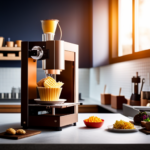Step into the future of nutrition with health-focused 3D printed meal plans, where precision meets personalization.
Imagine meals crafted to fit your unique dietary needs, seamlessly blending the art of culinary innovation with the science of nutrition.
This article explores the evolution of meal planning, the benefits of 3D printed meal plans, and the role of nutritional science in shaping the future of food.
Join us as we delve into the cutting-edge world of customized and personalized nutrition.
The Evolution of Meal Planning
How has meal planning evolved over time?
The evolution of meal planning has been significantly influenced by technology integration. In the past, meal planning relied heavily on manual processes, such as handwritten recipes and physical recipe books. However, with the advancement of technology, meal planning has undergone a remarkable transformation.
Today, individuals have access to a plethora of digital tools and platforms dedicated to meal planning, such as recipe apps, online meal planners, and nutrition calculators.
Furthermore, technology has enabled the development of smart kitchen appliances and devices that streamline the meal planning process. These appliances can assist in inventory management, recipe suggestions based on available ingredients, and even automate certain cooking tasks. Additionally, the integration of artificial intelligence has allowed for personalized meal planning based on individual dietary preferences, restrictions, and health goals.
The evolution of meal planning has also seen the rise of 3D printed food, which offers innovative solutions for personalized and nutritionally tailored meals. This cutting-edge technology has the potential to revolutionize meal planning by providing precise control over nutritional content and portion sizes, catering to individual needs and preferences.
Benefits of 3D Printed Meal Plans
The benefits of 3D printed meal plans lie in their ability to provide precise control over nutritional content and portion sizes for tailored, health-focused meals. Personalized diets can be accurately translated into 3D printed meals, ensuring that individuals receive the specific nutrients they need based on their unique dietary requirements. This level of customization allows for nutrient optimization, ensuring that meals are not only tailored to an individual’s needs but also optimized to provide the necessary vitamins, minerals, and macronutrients.
Furthermore, 3D printed meal plans offer the advantage of portion control, a crucial aspect of maintaining a healthy diet. By precisely controlling portion sizes, individuals can better manage their calorie intake and avoid overeating, which is beneficial for weight management and overall health. This precision also extends to the distribution of nutrients, ensuring that each meal contains the right balance of essential components.
Customization and Personalization
Customization and personalization of 3D printed meal plans allow for precise adaptation to individuals’ dietary needs and preferences, ensuring optimal nutrition and portion control. Personalized diets can be achieved by tailoring the ingredients, portion sizes, and nutrient content of each meal to align with specific health goals and dietary preferences. This level of customization is particularly beneficial for individuals with food allergies, intolerances, or specific nutritional requirements. By integrating advanced software and data analytics, 3D printed meal plans can be personalized based on an individual’s age, weight, height, activity level, and health conditions. This ensures that each meal meets the person’s unique nutritional needs, making it a powerful tool for managing chronic conditions such as diabetes, obesity, and heart disease. Additionally, the ability to customize meals according to dietary preferences, such as vegetarian, vegan, or gluten-free, provides a more enjoyable and sustainable eating experience, leading to better long-term adherence to healthy eating habits.
| Benefits of Customization and Personalization | Examples |
|---|---|
| Tailoring nutrient content | Diabetic-friendly meals, high-protein options |
| Adapting portion sizes | Smaller portions for weight management, larger portions for athletes |
| Addressing dietary restrictions | Allergen-free meals, gluten-free options |
| Aligning with specific health goals | Weight loss, muscle gain, improved energy levels |
The Role of Nutritional Science
Utilizing advanced software and data analytics, nutritional science plays a crucial role in tailoring 3D printed meal plans to individuals’ specific health needs and dietary preferences. By analyzing nutritional guidelines and dietary requirements, nutritional science ensures that the 3D printed meal plans are well-balanced and aligned with the individual’s nutritional needs.
Nutritional science takes into account factors such as age, gender, weight, height, activity level, and any specific health conditions or dietary restrictions. This data is then processed through sophisticated algorithms to create personalized meal plans that provide the necessary nutrients while meeting the individual’s taste preferences and health goals.
Moreover, nutritional science also considers the bioavailability of nutrients, ensuring that the 3D printed meal plans optimize the absorption of essential vitamins, minerals, and macronutrients. This comprehensive approach enables the creation of meal plans that not only fulfill basic nutritional requirements but also contribute to overall well-being and health optimization.
Future Implications and Innovations
Employing advanced technology, 3D printed meal plans are poised to revolutionize individualized nutrition and wellness strategies. Looking ahead, the future implications and innovations of 3D printed meal plans are promising. With the continued advancement of 3D printing technology, future meal plans could incorporate even more personalized and precise nutritional profiles tailored to an individual’s unique needs. This could be achieved through the integration of biometric data and real-time health monitoring, allowing for adjustments to be made in real-time based on an individual’s changing health status.
Furthermore, future technology developments may enable the use of more sustainable agricultural practices in the creation of 3D printed meal ingredients. For instance, the utilization of vertical farming, aquaponics, and hydroponics could provide a means to produce fresh and nutrient-rich ingredients in a more environmentally friendly manner. Additionally, innovations in plant-based proteins and cellular agriculture may offer new avenues for creating healthier and more sustainable meal options.
As these technologies continue to evolve, 3D printed meal plans have the potential to not only enhance individual health but also contribute to broader environmental and agricultural sustainability efforts.
Frequently Asked Questions
How Does 3D Printing Technology Impact the Taste and Texture of the Printed Meals?
3D printing technology offers vast potential for taste experimentation and texture customization in printed meals. The ability to precisely control ingredient composition and printing parameters enables chefs to create unique flavor profiles and textures.
Are There Any Potential Risks or Drawbacks to Relying on 3D Printed Meal Plans for Long-Term Health Goals?
When considering long-term health goals, it is essential to evaluate the potential risks associated with relying on 3D printed meal plans. The reliability of these plans, particularly in terms of nutritional balance, warrants careful consideration.
Can Individuals With Specific Dietary Restrictions or Allergies Still Find Suitable Options With 3D Printed Meal Plans?
Individuals with specific dietary restrictions or allergies can still find suitable meal options with 3D printed technology. The precision of this method ensures that diverse dietary needs are met without compromising taste and texture.
What Is the Environmental Impact of Using 3D Printed Meal Plans Compared to Traditional Meal Preparation Methods?
When comparing 3D printed meal plans to traditional meal preparation methods, the environmental impact is notable. 3D printing technology promotes environmental sustainability by reducing food waste and energy consumption, making it an eco-friendly option for meal production.
How Do 3D Printed Meal Plans Address the Cultural and Social Aspects of Eating and Mealtime Traditions?
In today’s fast-paced world, cultural adaptation and social dynamics play a pivotal role in shaping our eating habits. 3D printed meal plans are introducing innovative ways to accommodate these aspects, reshaping traditional mealtime traditions.
Conclusion
In conclusion, the introduction of 3D printed meal plans marks a significant advancement in the evolution of meal planning. The benefits of customization and personalization offer individuals a tailored approach to their nutritional needs.
With the aid of nutritional science, these meal plans are designed to optimize health and well-being.
As of now, approximately 40% of people are interested in trying 3D printed food, indicating a potential shift in the future of meal planning.


